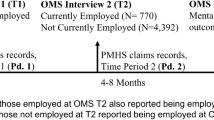Abstract
Adults with severe and persistent mental illness who received employment services through mental health and/or vocational rehabilitation programs had higher employment rates than individuals who did not receive any employment services. Individuals who received services from both programs had significantly higher employment rates than individuals who received services from only one program. Results indicate that employment services had a greater relative effect on older clients and clients with a schizophrenia diagnosis than on other individuals. This state-wide study relied exclusively on analysis of administrative/operational databases that provide the employment rates for both recipients of vocational services and other clients.
Similar content being viewed by others
REFERENCES
Banks, S. M. & Pandiani, J. A. (2001a). Probabilistic population estimation of the size and overlap of data sets based on date of birth. Statistics in Medicine, 20, 1421–1430.
Banks, S. M. & Pandiani, J. A. (2001b). Using existing data bases to measure treatment outcomes. In: M. Hernandez, S. Hodges H. Paul (Eds.), Developing outcome in children's mental health. Baltimore, MD: Brookes Publishing Co. 203–217.
Becker, D. R. & Drake, R. E. (1994). Individual placement and support: A community mental health center approach to vocational rehabilitation. Community Mental Health Journal, 30(2), 193–206.
Becker, D. R., Smith, J., Tanzman B., Drake, R. E., & Tremblay, T. (2001). Fidelity of supported employment programs and employment outcomes. Psychiatric Services, 52(6), 834–836.
Bond, G. R., Becker, D. R., Drake, R. E., & Vogler, K. M. (1997). A fidelity scale for the individual placement and support model of supported employment. Rehabilitation Counseling Bulletin, 40(4), 265–284.
Bond, G. R. (1998). Principles of the individual placement and support model: Empirical support. Psychiatric Rehabilitation Journal, 22(1), 11–23.
Campbell, J. (1993). The Well-being Project: Mental Health Clients Speak for themselves. Paper presented at the annual Conference on Mental Health Services Research and Evaluation, Arlington VA.
Cohen, J. (1988). Statistical power analysis for the behavioral sciences, 2nd Edition, Mahwah, NJ: Lawrence Erlbaum Associates.
Cook, J. A. & Razzano, L. (2000). Vocational rehabilitation for persons with schizophrenia: Recent research and implications for practice. Schizophrenia Bulletin, 26(1):87–103, 2000.
Drake, R. E., Becker, D. R., Xi, H. & Anthony, W. A. (1995). Barriers in the brokered model of supported employment for persons with psychiatric disabilities. Journal of Vocational Rehabilitation, 5, 141–149.
Drake, R. E., McHugo, G. J., Becker, D. R., Anthony, W. A., & Clark, R. E. (1996). The new hampshire study of supported employment for people with severe mental illness. Journal of Consulting and Clinical Psychology, 64(2), 391–399.
Drake, R. E., McHugo, G. J., Bebout, R. R., Becker, D. R., Harris, M., Bond, G. R. et al. (1999). A randomized clinical trial of supported employment for inner-city patients with severe mental disorders. The Archives of General Psychiatry, 56, 627–633.
Gowdy, E. A., Carlson, L. S., & Rapp, C. A. (2003). Practices differentiating high-performing from low-performing supported employment programs. Psychiatric Rehabilitation Journal, 26(3), 232–239.
Hedges, L. V. & Olkin, I. (1985). Statistical methods for meta-analysis. New York, NY: Academic Press.
National Association of State Mental Health Program Directors (2002). Performance Measures for Mental Health Systems (http://www.rdmc.org/nri/document.htm).
Pandiani, J. A., & Banks, S. M., (2003). Large data sets are powerful. Psychiatric Services, 54(5), 746.
Pandiani, J. A., & Simon, M. M. (2003, June 20). Type of employment for CRT clients and other Vermont residents. Vermont Department of Developmental and Mental Health Services. Available at: www.state.vt.us/dmh/Data/PIPs/2003/pip062003.pdf.
Pickett-Schenk, S. A., Cook, J. A., Grey, D., Banghart, M., Rosenheck, R. A., & Randolph, F. (2002). Employment histories of homeless persons with mental illness. Community Mental Health Journal, 38(3), 199–211.
Rosenheck, R. A., Banks, S. M, Pandiani, J. A., & Hoff, R. (2000). Bed closures and incarceration among users of VA behavioral health services in upstate New York. Psychiatric Services, 51(10), 1282–1287.
Substance Abuse and Mental Health Services Administration (SAMHSA). (DRAFT). Achieving the Promise: Transforming Mental Health Care in America. Community Mental Health Services Block Grant Application Guidance and Instructions FY 2005–2007. CFDA No. 93.958.
Author information
Authors and Affiliations
Rights and permissions
About this article
Cite this article
Pandiani, J.A., Simon, M.M., Tracy, B.J. et al. Impact of Multi-Agency Employment Services on Employment Rates. Community Ment Health J 40, 333–345 (2004). https://doi.org/10.1023/B:COMH.0000035228.46724.97
Issue Date:
DOI: https://doi.org/10.1023/B:COMH.0000035228.46724.97



